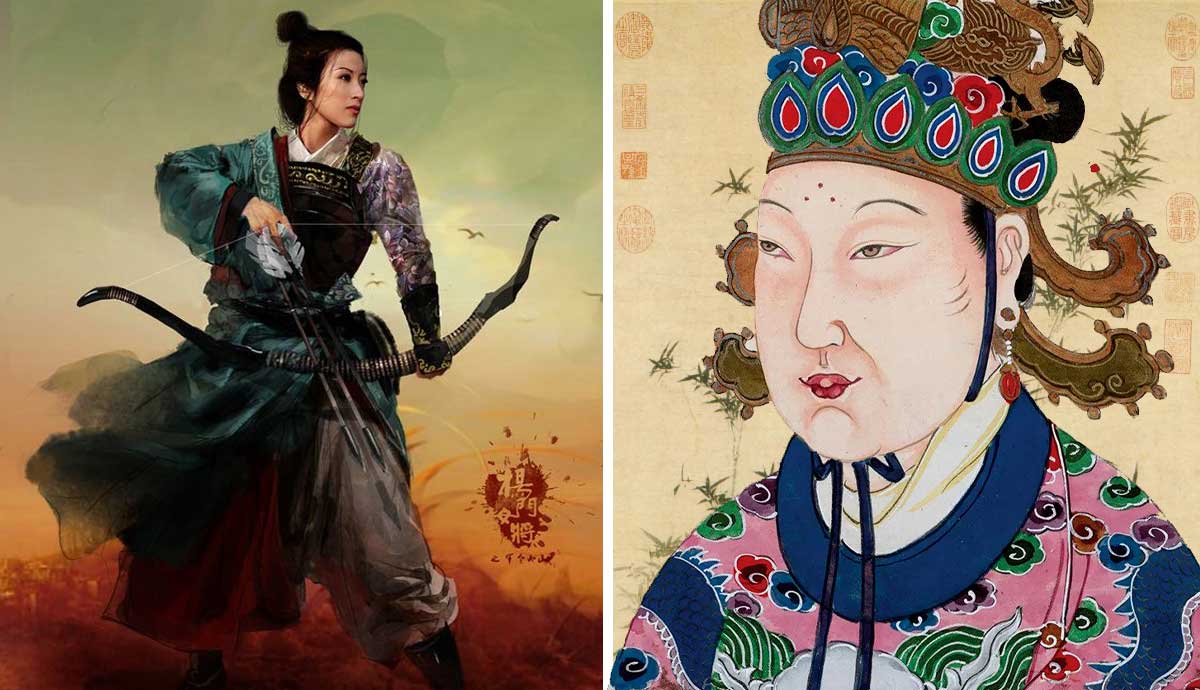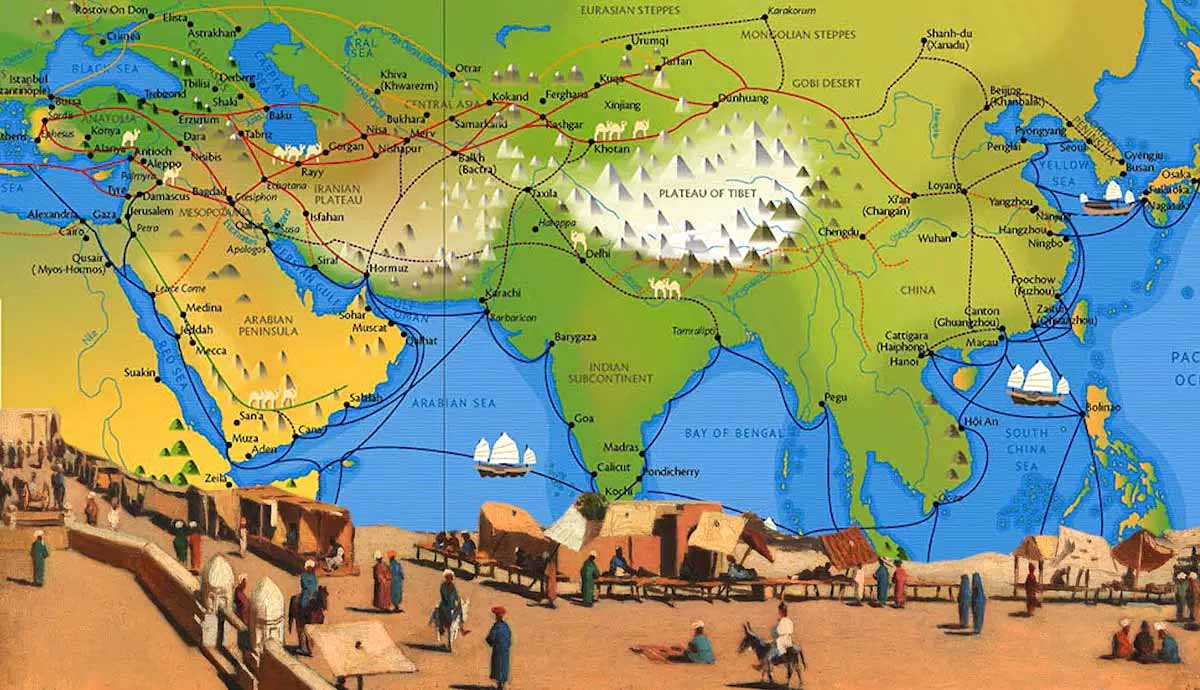
From the early medieval period to the High Middle Ages, there was a multitude of famous Chinese women, who helped to shape the way China developed. From great empresses to poets, the following list of famous Chinese women has been compiled with regard to their impact on Chinese history, culture, society, and the role of women in this period. Although Chinese society was a heavily male-dominated society throughout the medieval period, nevertheless there were still a number of women who more than held their own against their male counterparts, and to this day, stand out as key figures in Chinese history.
1. Princess Pingyang (c. 590s – 623)

The first famous Chinese woman on this list is Princess Pingyang, who was born sometime during the 590s. She was the daughter of Li Yuan, who became the founding emperor of the Tang Dynasty, which ruled China from 618-690, and again from 705-907. She famously helped her father to seize power from the short-lived Sui Dynasty (581-618).
In 617, Li Yuan (Princess Pingyang’s father) planned to rebel against Emperor Yang of Sui, as he had previously been imprisoned by him. He sent a letter to his daughter and her husband, Chai Shao, summoning them back to Taiyuan, as they were both currently in the Sui capital of Chang’an.
Chai Shao was not convinced that the pair of them would be able to escape, but Pingyang told him to go regardless, saying that she, as a woman, would be able to hide more easily. After a short period of hiding, Pingyang distributed her wealth among several hundred men and received their loyalty. She then openly rose up in support of her father.
Pingyang sent her servant, Ma Sanbao, to persuade other rebel leaders to join her, and a multitude of them did: He Panren, Li Zhongwen, Xiang Shanzhi, and Qui Shili. She then led these rebel leaders and their supporters and captured some of the nearby cities. In all, she had amassed a force of 70,000 men.

Following Pingyang’s victories, Li Yuan crossed the Yellow River into the Chang’an area and sent Chai Shao (who had successfully escaped and met up with Li Yuan) to rendezvous with Pingyang. They both commanded separate wings of the army and they were both granted the role of General. Pingyang’s force was known as the “Army of the Lady”.
The following year, Li Yuan had Emperor Yang’s grandson yield the imperial throne to him, and he established the Tang Dynasty, crowning himself as Emperor Gaozu, and his daughter as Princess Pingyang.
Princess Pingyang died a few years later, in 623. Her father ordered her a grand military funeral, like a military general would have. However, ministers in the Ministry of Rites denied her this, arguing that it was not suitable for a band to perform at a woman’s funeral. Emperor Gaozu responded: “As you know, the princess mustered an army which helped us overthrow the Sui Dynasty. She participated in many battles, and her help was decisive in founding the Tang Dynasty…She was no ordinary woman.”
2. The Formidable Empress: Wu Zetian (17 February 624 AD/CE – 16 December 705 AD/CE)

During over three millennia of imperial rule, Wu Zetian was the only woman to ever rule China in her own right, so no list of famous Chinese women is complete without her.
Wu was born on the 17th of February 624 in Lizhou China, under the Tang Dynasty, and her father was a wealthy man. As a result, he ensured that she received a good education, which was unusual for women at the time. She was taken to be a concubine of Emperor Taizong (r. 626-49) at age 14, but due to her beauty and intelligence, the emperor promoted her to be his secretary instead.
However, while Emperor Taizong was still alive, Wu had an affair with his son, Li Zhu. Taizong died in 649, and Li succeeded him as Emperor Gaozong. In Tang China, when an emperor died, it was expected that all his concubines would shave their heads and live their lives out of court in chastity. However, Gaozong ordered Wu back to court almost as soon as he had taken the imperial throne.
In 654, Wu gave birth to a baby, but it died. She accused Empress Wang — the emperor’s wife — of murdering the baby out of jealousy. Gaozong believed Wu, and deposed his wife. Wu became his consort the following year. However, some historians think that Wu murdered her own baby in order to frame Empress Wang in a power struggle.

Gaozong died in 683, and Wu became Empress dowager to her son, Li Zhe, who became Emperor Zhongzong. However, he showed signs of disobeying his mother, so with her allies, she sent him into exile, and her youngest son, Li Dan became Emperor Ruizong instead. It is little surprise that Ruizong never appeared at court. In 690, Wu deposed him and declared herself Empress Regnant.
Empress Regnant Wu then declared that she had established her own dynasty, called the Zhou Dynasty, which was named after the long-reigning ancient Chinese dynasty of the same name (1046-256 BC/BCE). As a result, the period was known as the Wu Zhou Dynasty, but as Wu was the only ruler, it does not really fit in with the other traditional dynasties, which involved a number of successors from one family. The Wu Zhou Dynasty ended with just her.
Wu was known as a cruel ruler, who had thousands of rival families imprisoned, and numerous aristocrats murdered. However, she was strangely viewed as a popular and much-loved monarch. This is partly due to her coming to the throne at a time of relative economic stability, and also because many of her suggestions for reform came from the people themselves.
She also pursued a policy of military expansionism, extending China’s borders to its furthest extent thus far in Central Asia, while also reclaiming territory which had been lost to the Tibetan Empire in 670. She reopened the Silk Road, which had been closed since 682 due to outbreaks of plague and nomadic tribes killing travelers.
By the late 690s, Wu was forced to abdicate as she was spending more time with her young lovers than ruling China. She abdicated in favor of her exiled son, Zhongzong, who was reinstated as emperor of the Tang Dynasty. Wu died a year later, aged 81.
3. The Masterful Poet: Li Qingzhao (1084 – c. 1155)

Not all of the women on this list are members of the royal imperial families and this one is a fine example: a poet, who is one of the most famous Chinese women of the medieval era.
Li Qingzhao was born in 1084 in Jinan, Shandong, on the eastern coast of China, during the Song Dynasty (960-1279). Her father was an academic professor, and her mother was a poet. Li received a good education, and studied literature during her teen years.
When she was 18, she married Zhao Mingcheng, an essayist, poet, and politician. Together, they collected inscriptions and calligraphy, and it is reported that they had a happy marriage. Li’s happy marriage was reflected in the nature of her poetry, which took on a calm and elegant tone. As both were keen poets, they often wrote poems for each other, describing items that fascinated them, such as bronze architecture from the Shang (c. 1570 BC/BCE – c. 1045 BC/BCE) and Zhou Dynasties.
However, with the onset of the Jin-Song Wars (1125-1234) Li and Zhao were forced to flee south of the Yangtze River, and they settled in Nanjing. Zhao died a year later, which left Li devastated. She moved to Hangzhou, and her poetry during this period of her life was often full of nostalgic memories of her husband.
Li died around 1155, aged approximately 71. Unfortunately, during the turbulent years that followed, the majority of her work was lost, and only around 100 poems remain. However, her legacy lives on: there are various memorial halls dotted around China which are named after her, as well as two craters on the planets Mercury and Venus.
4. The Brilliant Artist: Guan Daosheng (1262 – 1319)

Much like Li Qingzhao, Guan Daosheng is remembered for her cultural significance, making her another famous Chinese woman on this list who was not a member of the nobility: she was a painter and calligrapher.
Born in Huzhou in eastern China around 1262, she received a good education and was evidently highly talented; her father thought very highly of her from the moment she was born, as her name literally translates as “Way of Righteousness Rising as the Sun”.
When she was around 24 years old, she married Zhao Mengfu, who was a renowned artist at the time. They raised four children together, as well as Zhao’s children from a previous marriage, and due to the nature of Zhao’s work as an imperial calligrapher, painter, and scholar, they traveled around China regularly. This gave Guan access to leading artists of the era, and also gave her the opportunity to visit places and see artworks that many women would not have had access to.

After Kublai Khan had finalized the Mongol conquest of China and formally established the Yuan Dynasty (1279-1368), he wanted the most talented Chinese scholars to help establish cultural control over the Chinese population. Zhao was employed by Kublai Khan, and again this gave Guan the opportunity to display her own works at the imperial court, too.
Much of her work depicts the traditional style of Chinese art: using fine brushstrokes to paint scenes of ink bamboo, and it is also believed that both Zhao and Guan painted many works together.
In 1319, Guan died after a long illness. Following her death, Zhao painted numerous bamboo paintings in Guan’s honor and memory, as that was one of her favorite subjects to paint. Her tombstone was marked in the same way as would be given to a feudal lord, once again reinforcing the high honor that had been bestowed upon her, and the impact that she had on Chinese art and culture.
5. The Last of Our Famous Chinese Women: The Cultural Collector Sengge Ragi (c. 1283 – 1331)

The final woman on this list of famous Chinese women from medieval China is Sengge Ragi, a late thirteenth and early fourteenth-century collector of Chinese calligraphy and works of art from the Song Dynasty.
Sengge was born around 1283 and was a great-granddaughter of Kublai Khan. She had three brothers, (one a step-brother, and the other two full brothers), of whom the latter two both became emperors (Khayishan, r. 1307-11 and Ayurbarwada, r. 1311-20), which is why she rose to fame and gained prominence at the Chinese courts. She was granted the titles of Grand Princess of Lu, and Princess Supreme of Lu in 1307.
In 1323, Sengge hosted an “elegant gathering”, which was a historic moment as it was held by a woman — usually these sorts of cultural events were held by men. Numerous scrolls were brought out to the attendees, who were instructed to add colophons to them. About 15 of these still survive today. She was also noted for her charitable acts, as a result of her Buddhist faith.
A year later, Sengge’s daughter Budashiri married Tugh Temür (who was Budashiri’s own cousin, and Sengge’s nephew). Tugh Temür helped to increase his mother-in-law’s position considerably when he ascended the throne in 1328, by granting her huge sums of money so that she could build her own residence and own plots of land.
Unfortunately, Sengge died in early 1331, so she did not have much time to enjoy her new residence. Nevertheless, thanks to her charitable work and her collection of arts and cultural items, she deserves a place on the list of famous Chinese women from medieval China.










